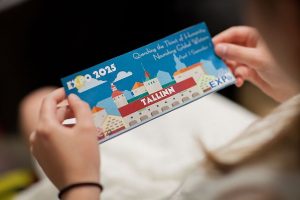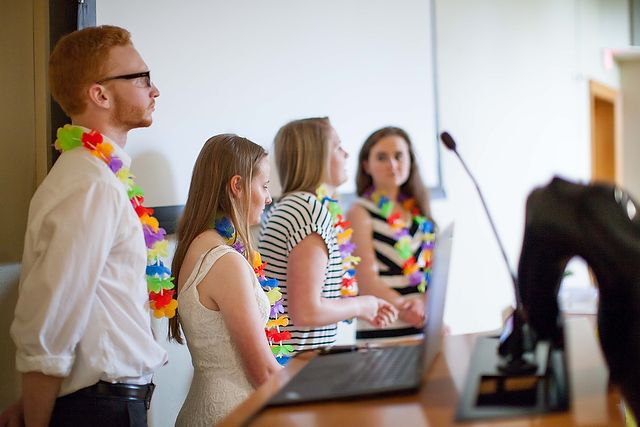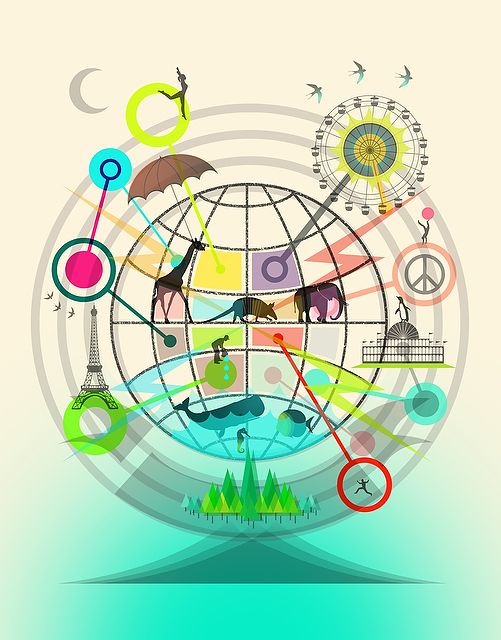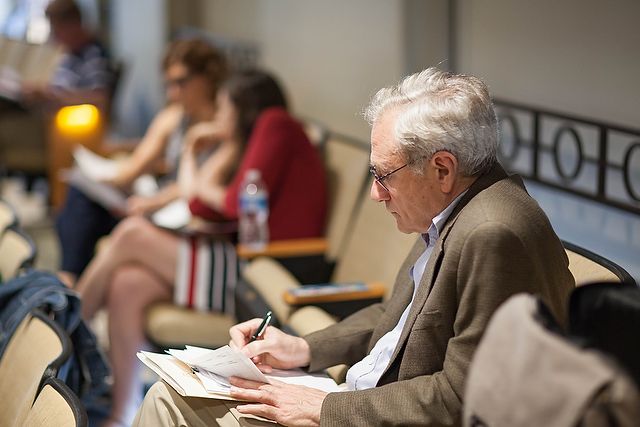 “Meet Me at the Fair,” a 2016 first-year seminar
“Meet Me at the Fair,” a 2016 first-year seminar
 Plan the 2025 World’s Fair
Plan the 2025 World’s Fair
 16 first-year students
16 first-year students
The Background:
“For 165 years, these events have represented an international, cooperative effort to bring the best of human cultures and achievements into conversation (and often competition), so it made sense to get students thinking about how Expos have represented — even if somewhat problematically at times — ideas of human progress and how a future Expo might do the same.”
— Ryan Shirey, associate teaching professor in the Writing Program and director of the Writing Center
THE PROFESSORS:
Ryan Shirey, English and writing
Lisa Blee, history
Christa Colyer, chemistry
Louis Goldstein (P ’93, ’06), music
Katy Lack (PhD ’08), biology and neuroscience
Ali Sakkal, education
Christina Soriano, dance
FACULTY PREP:
A week at Worrell House in London to develop an interdisciplinary, team-taught course focused on global issues and intercultural communication skills, and a group visit to the 2015 World’s Fair in Milan, Italy.
INSPIRATION:
Previous World’s Fairs have introduced the Ferris wheel, the Eiffel Tower, the Space Needle, the telephone, the sewing machine, the elevator, television, touch-screen technology and the ice cream cone.
 ASSIGNMENT, PART 1:
ASSIGNMENT, PART 1:
Study the legacies of previous fairs — including London 1851, Paris 1889, St. Louis 1904, New York 1939 and 1964, Brussels 1958, Montreal 1967 and Milan 2015 — and texts including “Meet Me at the Fair: A World’s Fair Reader” and “Expo: International Expositions 1851-2010.”
 ASSIGNMENT, PART II:
ASSIGNMENT, PART II:
Research and write about what goes into planning a World’s Fair: geography, social and political concerns, health care, finances, environmental impact, transportation, infrastructure, educational goals, sustainability, entertainment and marketing.
FINAL PROJECT:
On exam day students present their plans for the 2025 World’s Fair, showcasing Bogota, Colombia; Hanoi, Vietnam; Accra, Ghana; and Tallinn, Estonia.
BOGOTA Colombia
The theme: “Biodiversity: Revealing the Purpose of Every Species in an Ever Growing World”
One solution: A pavilion shaped like a giant armadillo to highlight endangered species
Meghan Faherty’s inspiration: “I want to raise awareness about the species and ways to protect it from extinction.”
ACCRA Ghana
The theme: “Promoting Health to Brighten the Future”
One solution: A “walk of shame” through an artificially polluted room into a brighter, cleaner future
Meghan Hurley’s inspiration: “I want visitors to be frightened when they enter because they’re going to be walking through pathways filled with trash and thick smog.”
TLLINN Estonia
The theme: “Quenching the Thirst of Humanity, Nourishing Global Waters”
One solution: An Aquatic Kingdom pavilion of ocean habitats and species of each continent
Rex Carr’s inspiration: “To show how our actions have affected water species and what steps are being taken to improve their quality of life.”
HANOI Vietnam
The theme: “Peace and Progress: In Order to Go Forward, We Must Look Back”
One solution: A pavilion without walls for Doctors Without Borders
Madi Lyford’s inspiration: “The right to medical care outweighs respect for national boundaries.”
What’s Your Plan, professors?
We turned the tables on professors who taught “Meet Me at the Fair” and asked how they would highlight their discipline at a World’s Fair 20 years from now.
LISA BLEE
Associate Professor of History
In some past fairs, visitors have been invited to fill time capsules with items representative of their times. In a World’s Fair pavilion 20 years from now, I would like to see an exhibit of 19th- and 20th-century time capsules and visitors’ reflections on their time at recent fairs. What I imagine such a pavilion will show is that technology and popular culture may be rapidly changing, but peoples’ efforts to understand the diverse world they live in and their individual place within it is a shared endeavor that spans generations. Rather than focusing on progress, such an exhibit would tell a more humbling story of evolution, persistence and connections across time.
CHRISTA COLYER
Associate Dean for Academic Planning Professor of Chemistry
Robert and Debra Lee Faculty Fellow
The chemical giant DuPont presumed very little quantitative literacy on the part of fairgoers at the 1964 New York World’s Fair, and so they dazzled audiences with thinly veiled product advertisements in the form of Broadway-like shows and colorful chemical demonstrations featuring polymers and new synthetic materials. But in 2036, fairgoers will be too scientifically savvy to be passive consumers of corporate science. The idea of science being inaccessible to the average citizen will be replaced with the growing movement of “citizen science,” where everyone can contribute to massively collaborative research projects. What better place than a World’s Fair to serve as a worldwide laboratory with millions of attendees playing the role of scientist?!
LOUIS GOLDSTEIN (P ’93, ’06)
Professor of Music
I would love to see a World’s Fair with a focus on sound. One aspect of this theme would continue recent World Expo concerns with sustainability and food production in that the phenomenon of sound pollution would be examined; what are the physiological and psychological ramifications of too much sound, and what is the value of silence? But the real hook for me would be seeing pavilion after pavilion with specially designed auditoriums built for the sole purpose of transmitting sound and providing ideal venues for displaying their country’s best and most experimental explorations into using sound to generate beauty and to create nonverbal meaning.
KATY LACK (PHD ’08)
Assistant Teaching Professor, Biology and Neuroscience
For my pavilion of the future I would design one that represents the progress made on the Human Connectome Project. The pavilion itself would represent the brain and visitors could walk along white matter tracts to specific brain regions. Of course, we would have to make it interactive and so the visitors would be able to stimulate the brain area in which they are standing and watch as that stimulation initiates “action potentials” that zoom along paths to other brain regions. Hopefully visitors would take away with them an understanding of the beauty and complexity of the brain.
ALI SAKKAL
Assistant Teaching Professor of Education
The 1904 St. Louis Expo proudly displayed the Philadelphia Public Schools as a school system of the future. In the future, as higher education becomes the norm rather than the exception around the globe, I can envision a future expo capturing a magnificent and global system of schooling from prekindergarten to university as a colossal feat of knowledge, organization and technology. A future expo might capture our remarkable abilities to attend high quality learning environments through virtual interfaces that contribute to our ever-expanding notion of a global village.
RYAN SHIREY
Associate Teaching Professor in the Writing Program
Director of the Writing Center
I believe (and hope) that future Expos will continue to move to cities and countries around the globe that have had fewer chances to be in the spotlight. To be truly global, Expos need to embrace parts of the world whose relationships to globalization, industrialization and technology might look somewhat different from those in Europe or North America. Expos always become shared experiences that then circulate in creative ways — often through writing. Without the 1939 New York World’s Fair, for example, we wouldn’t have E.L. Doctorow’s novel, “World’s Fair.” From Charlotte Brontë and William Makepeace Thackeray in 1851 all the way to the present, writers have always responded to the sense of possibility that accompanies Expos.
CHRISTINA SORIANO
Associate Professor of Dance
In my future World’s Fair, visitors would encounter dancing at every participating country’s pavilion; from historically significant dances to current dance forms happening in theatres, museums, street corners or village squares throughout the world. Dance artists from every country would be employed as cultural ambassadors during the fair on a rotating basis, with paid commissions to create site-specific dances, inviting visitors to both watch and participate in the newest dances their country has to offer the world.






